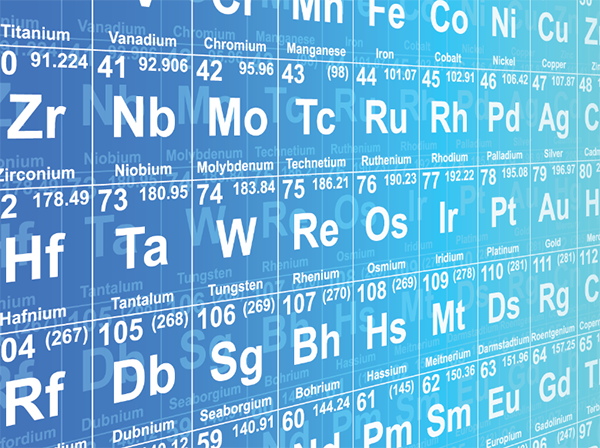Key Concepts
Atoms with the same atomic number; that is, the same number of protons in their atomic nucleus. Some common elements are oxygen, hydrogen, iron, copper, gold, silver, nitrogen, chlorine, and uranium (see illustration). Most of the elements are solids at room temperature, two of them (mercury and bromine) are liquids, and the rest are gases.

Occurrence and classification
A few of the elements are found in nature in the free (uncombined) state. Some of these are oxygen, nitrogen, the noble gases (helium, neon, argon, krypton, xenon, and radon), sulfur, copper, silver, and gold. Most of the elements in nature are combined with other elements in the form of compounds. The most abundant element on the Earth is oxygen; the next most abundant is silicon. The most abundant element in the universe is hydrogen and the next most abundant is helium. See also: Geochemical distribution of elements
The elements are classified in families or groups in the periodic table. Elements are also classified as metals and nonmetals. A metallic element is one whose atoms form positive ions in solution, and a nonmetallic element is one whose atoms form negative ions in solution. See also: Periodic table
Atoms of a given element have the same atomic number, but may not all have the same atomic weight. Atoms with identical atomic numbers but different atomic weights are called isotopes. Oxygen, for example, is made up of atoms whose atomic weights are 16, 17, and 18. Hydrogen is made up of isotopes 1, 2, and 3; the isotopes of masses 2 and 3 are called deuterium and tritium, respectively. Carbon is made up of isotopes 11, 12, 13, and 14. Carbon-14 is radioactive and is used as a tracer in many chemical experiments.
All the elements have isotopes, although in certain cases only synthetic isotopes are known. Thus, fluorine exists in nature as 19F, but the artificial radioactive isotope 18F can be prepared. Many of the isotopes of the different elements are unstable, or radioactive, and hence they disintegrate to form stable atoms either of that element or of some other element. See also: Atomic mass; Radioactivity
Origin
The origin of the chemical elements is believed to be the result of the synthesis by fusion processes at very high temperatures (in the order of 100,000,000°C or 180,000,000°F and higher) of the simple nuclear particles (protons and neutrons) first to heavier atomic nuclei such as those of helium and then on to the heavier and more complex nuclei of the light elements (lithium, boron, and so on). The helium atoms bombard the atoms of the light elements and produce neutrons. The neutrons are captured by the nuclei of elements and produce heavier elements. These two processes—fusion of protons and neutron capture—are the main ones forming the chemical elements. Furthermore, the energy of the Sun and the stars is derived primarily from the fusion of hydrogen nuclei and electrons to form helium nuclei. It is believed that this element-producing fusion process is occurring even today in hot stars. See also: Nucleosynthesis
Uses
Various metals are used for structural materials, protective coatings, ornamental devices, jewelry, and tableware. Such nonmetals as chlorine, bromine, hydrogen, sulfur, and nitrogen are important for the manufacture of many of the common chemicals of commerce.
Transuranium elements
A number of elements, found in only very slight traces or not at all in nature, have been synthesized. Those are the elements with atomic numbers above 92. These elements have been synthesized by a variety of nuclear reactions that involve transmuting atoms of one element into atoms of another by bombarding that element with neutrons or fast-moving particles (protons, deuterons, and alpha particles) which will change the atomic number to that of the new element. Not only have these elements been synthesized, but isotopes of all the other elements also have been synthesized. See also: Atomic structure and spectra; Transuranium elements





